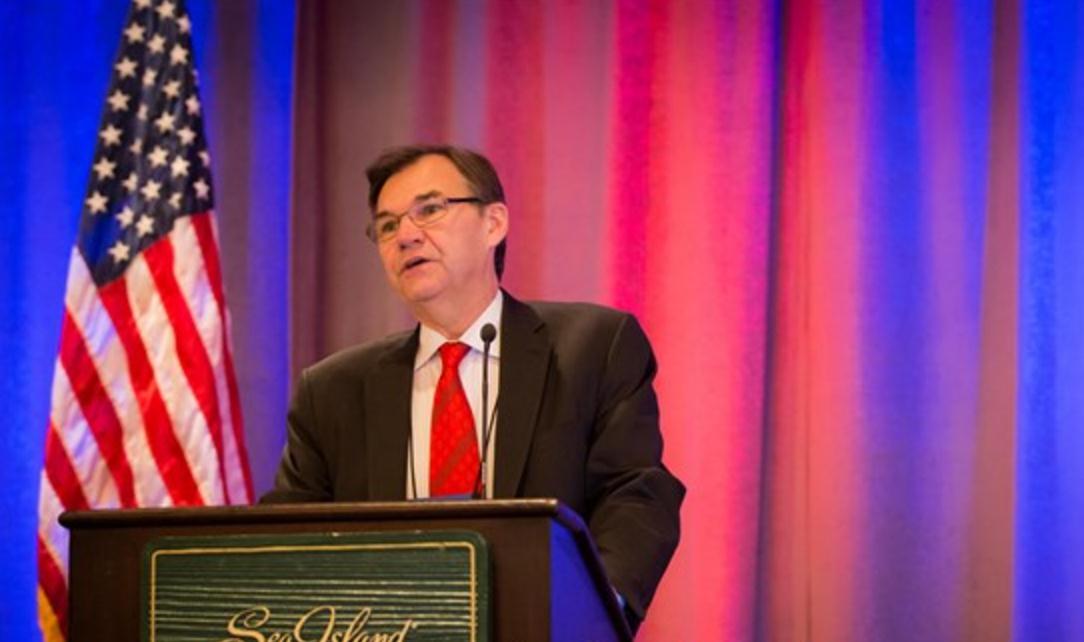Americans frustrated by slow economic growth and a lack of blue-collar manufacturing jobs are widely credited with electing Republican Donald Trump president last November. Although there was little official talk of the presidential election at the Georgia Foreign Trade Conference, numbers provided by Walter Kemmsies, an economist and managing director at real estate services provider JLL, shows that frustrated voters were not imaging a prolonged slowdown in the US economy.
“The fundamental problem is, in all of these years, we haven’t seen the public sector in our country as a whole step up and do what’s necessary to get us to prosperity,” he told attendees of the conference sponsored by the Georgia Ports Authority. “The fact is, economic growth and employment growth have slowed down. Part of it is natural because our population is ageing, and part of it is stupidity. We did some pretty dumb stuff in last 20-30 years, and it resulted in lower investment spending growth and therefore lower productivity growth and therefore lower GDP growth. It’s pretty straightforward,” he said.
Kemmsies also echoed the view of many Americans who believe that world trade has disproportionately benefitted the country’s trading partners. The Obama Administration’s negotiation of the Trans-Pacific Partnership, of which the US was to be the anchor member, became so unpopular with American voters that both Trump and Democratic challenger Hillary Clinton vowed to scuttle the deal were they to be elected president. In fact, withdrawing from the multilateral trade deal was one of the first actions undertaken by Trump.

“We have supported global trade. We have helped the world economy develop. A lot of people in the world today have a standard of living they wouldn’t have had the United States [not] made the decisions [it made],” Kemmsies said. “Unfortunately, we forgot about something: We didn’t invest in infrastructure. Every other country that signs a trade agreement turns around and invests in infrastructure to support its exports. What do we do? We didn’t even invest in infrastructure, must less for exports, and the consequence is, we didn’t benefit a lot from trade. Everybody else did, but we didn’t. We really need to wake up to that fact and not blame other countries and trade practices and things of that nature.”
Kemmseis said that a nagging spending deficit by the US government isn’t helping the economy. “The problem is that money is being spent on consumption, not on investment. To put it in really simple terms, if you borrow money to build a bridge, and you can charge a toll and the bridge pays for itself, that’s investment,” he says. “That’s a good thing to do. If you borrow money to throw a big beer party, the next day all you have is a lot of debt and a bunch of empty beer bottles. We didn’t put the money into anything productive.”
Another reason productivity remains low in the United States, Kemmsies says, is that investment spending hasn’t kept up with where it once was – or where it is in developing countries. Citing United Nations figures on developed countries, Kemmsies said that private investment spending has dropped from 19-20% to 16-17%. “Those four points are costing developed countries about 2% of productivity growth on an annual basis. If you don’t invest, you can’t increase the output per person. If you don’t have the capital, then the labour doesn’t become more productive.”
At the same time, thanks to monopolizations and consolidations in many industries, companies are seeing their profits as a share of GDP reach an all-time high. “What do they do with that money? Share buy-backs and dividends. That isn’t doing a whole hell of a lot for the country.”
Kemmsies says that the blame, however, doesn’t lie with the companies and Wall Street. “That’s not where the blame starts. What I see here are a bunch of companies concerned about the future, worried that there’s no leadership and therefore afraid to invest.”
Along with ageing populations and higher incomes, the world’s most developed countries, particularly North America, Europe and Japan, also have among the lowest amount of consumption – “older folks spend most of their money on services, not on goods,” Kemmsies says – which has contributed to the movement of manufacturing to lower-cost economies with younger populations which tend to consume more, such as India, Indonesia, Colombia, Mexico, China and Brazil, he said. “It would make sense for the factories to migrate there, with or without free trade agreements, with or without infrastructure investments. That’s the natural migration.”
Kemmsies says that free trade agreements tend to benefit manufactured goods, rather than upstream industrial goods or agricultural goods. “World trade has been skewed towards tennis shoes and away from soybeans,” he said.
Manufactured goods trade, most of which travels by container, has grown by about 7%, he says, which is almost double the rate of GDP growth. “When you look at fuels and mining products or agricultural products, they’ve been growing pretty much just in line with GDP.”
While Europe has balanced trade and Asia and Latin America have trade surpluses, the United States continues to run a trade deficit. “We’ve been the guys who have been helping the world along, but it’s cost us something. Our trade deficit [over the year] is US$480 billion, which is roughly 3% of our GDP. It doesn’t sound like much, does it? Well, there are 191 countries on the planet, and 480 billion dollars is bigger than the GDP of 168 of them, so this is a really big number when you start looking at it on a per capita basis or comparing it to other economies.”
By Gregory Glass
Asia Cargo News | Saint Simons Island, Georgia




